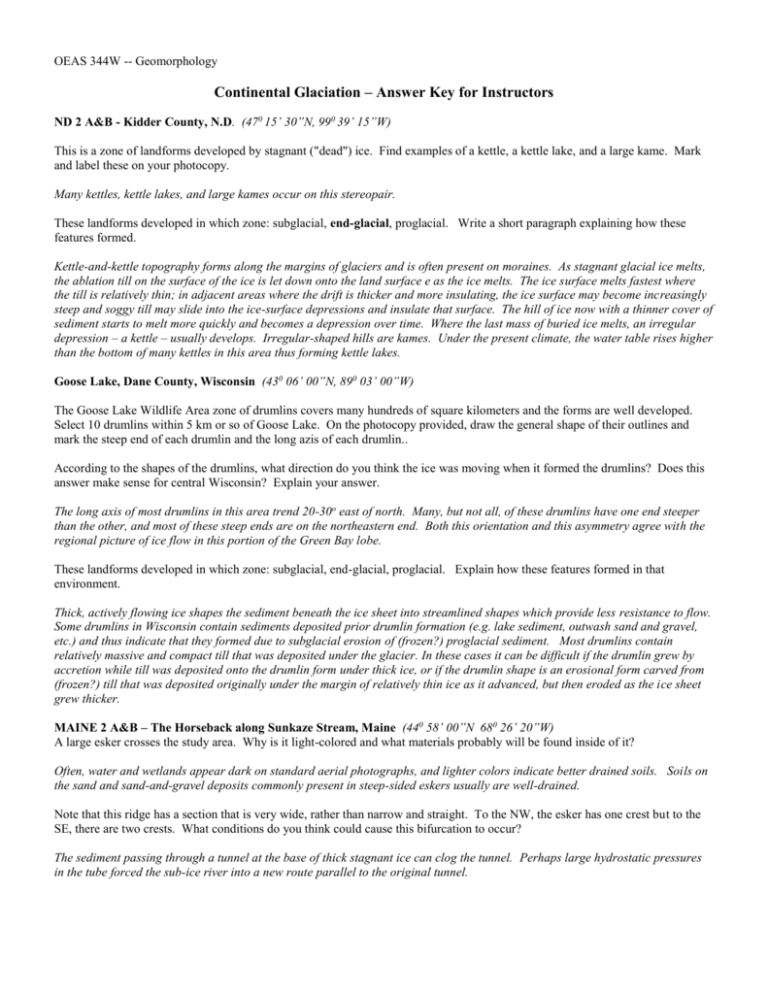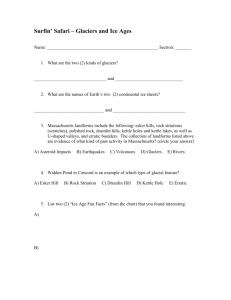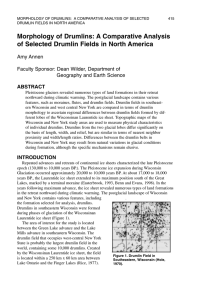Many kettles, kettle lakes, and large kames occur on
advertisement

OEAS 344W -- Geomorphology Continental Glaciation – Answer Key for Instructors ND 2 A&B - Kidder County, N.D. (470 15’ 30”N, 990 39’ 15”W) This is a zone of landforms developed by stagnant ("dead") ice. Find examples of a kettle, a kettle lake, and a large kame. Mark and label these on your photocopy. Many kettles, kettle lakes, and large kames occur on this stereopair. These landforms developed in which zone: subglacial, end-glacial, proglacial. Write a short paragraph explaining how these features formed. Kettle-and-kettle topography forms along the margins of glaciers and is often present on moraines. As stagnant glacial ice melts, the ablation till on the surface of the ice is let down onto the land surface e as the ice melts. The ice surface melts fastest where the till is relatively thin; in adjacent areas where the drift is thicker and more insulating, the ice surface may become increasingly steep and soggy till may slide into the ice-surface depressions and insulate that surface. The hill of ice now with a thinner cover of sediment starts to melt more quickly and becomes a depression over time. Where the last mass of buried ice melts, an irregular depression – a kettle – usually develops. Irregular-shaped hills are kames. Under the present climate, the water table rises higher than the bottom of many kettles in this area thus forming kettle lakes. Goose Lake, Dane County, Wisconsin (430 06’ 00”N, 890 03’ 00”W) The Goose Lake Wildlife Area zone of drumlins covers many hundreds of square kilometers and the forms are well developed. Select 10 drumlins within 5 km or so of Goose Lake. On the photocopy provided, draw the general shape of their outlines and mark the steep end of each drumlin and the long azis of each drumlin.. According to the shapes of the drumlins, what direction do you think the ice was moving when it formed the drumlins? Does this answer make sense for central Wisconsin? Explain your answer. The long axis of most drumlins in this area trend 20-30o east of north. Many, but not all, of these drumlins have one end steeper than the other, and most of these steep ends are on the northeastern end. Both this orientation and this asymmetry agree with the regional picture of ice flow in this portion of the Green Bay lobe. These landforms developed in which zone: subglacial, end-glacial, proglacial. Explain how these features formed in that environment. Thick, actively flowing ice shapes the sediment beneath the ice sheet into streamlined shapes which provide less resistance to flow. Some drumlins in Wisconsin contain sediments deposited prior drumlin formation (e.g. lake sediment, outwash sand and gravel, etc.) and thus indicate that they formed due to subglacial erosion of (frozen?) proglacial sediment. Most drumlins contain relatively massive and compact till that was deposited under the glacier. In these cases it can be difficult if the drumlin grew by accretion while till was deposited onto the drumlin form under thick ice, or if the drumlin shape is an erosional form carved from (frozen?) till that was deposited originally under the margin of relatively thin ice as it advanced, but then eroded as the ice sheet grew thicker. MAINE 2 A&B – The Horseback along Sunkaze Stream, Maine (440 58’ 00”N 680 26’ 20”W) A large esker crosses the study area. Why is it light-colored and what materials probably will be found inside of it? Often, water and wetlands appear dark on standard aerial photographs, and lighter colors indicate better drained soils. Soils on the sand and sand-and-gravel deposits commonly present in steep-sided eskers usually are well-drained. Note that this ridge has a section that is very wide, rather than narrow and straight. To the NW, the esker has one crest but to the SE, there are two crests. What conditions do you think could cause this bifurcation to occur? The sediment passing through a tunnel at the base of thick stagnant ice can clog the tunnel. Perhaps large hydrostatic pressures in the tube forced the sub-ice river into a new route parallel to the original tunnel. Delaware, Michigan Quadrangle (1:24,000) (460 27’ N, 880 50’ W) There are two types of ridges on this map. One set is oriented E-W, is asymmetric, and is generally very continuous and straight. The other ridges are approximately N-S, sinuous, discontinuous, and occasionally forked. Explain how these two sets of ridges formed. The asymmetric parallel ridges are bedrock hills formed in bedded Precambrian rocks dipping generally to the north. The low sinuous ridges are eskers and related ice-contact stratified drift. Kingston, R.I. Quadrangle (1:24,000) The Wisconsinan terminal moraine was deposited several kilometers south of this map area and is now mostly submerged. For each of the following landforms, (1) describe and identify the landform, (2) note whether this landform formed in a subglacial, end-glacial, or proglacial environment, and (3) predict whether this landform is made of till or sand-and-gravel. a. the broad landform about 2 km wide that includes Bull Head Pond, Broad Hill, and the town of Snug Harbor recessional end moraine – end-glacial- predicted to be till b. the plain underlying Matunuck Beach Road between Matunuck and U.S. 1. (410 23’ 30”N, 710 33’ 00”W) Sandur (outwash plain) – proglacial – sand-and-gravel c. Great Neck and Tobey Neck, just N of Worden Pond Probably drumlins – subglacial (active ice) – till or other drift. Could be roches moutonees made of bedrock. d. the plain immediately west of the campus of the University of Rhode Island in Kingston pitted outwash plain – proglacial sandur that buried ice block remnants - sand with gravel e. the depression containing Larkin Pond kettle – end-glacial stagnant ice block - surrounded by sand-and-gravel f. hill immediately N of the work "Brook" labeling Mink Brook that debouches into Worden Pond (410 20’ 02”N, 710 32’ 41”) kame terrace - end-glacial stagnant ice - sand-and-gravel g. the very round hill immediately S of Asa Pond (N of Wakefield) (410 27’ 25”N, 710 30’ 51”W) moulin kame – end-glacial under thick stagnant ice – sand-and-gravel h. Blackberry Hill and Green Hill located between US 1 and Block Island Sound Drumlins, probably formed at the same time as Great Neck and Tobey Neck - subglacial - till or other sediment i. the string of lakes from Tucker Pond to Potter Pond tunnel valley track (marked by kettles formed where ice blocks that filled the abandoned subglacial river were eventually buried by the recessional end moraine before melting and collapsing into the kettles) - subglacial then end-glacial Each of these landforms developed at one of three distinctive periods when the active ice margin was at a different location. For each active ice margin position, list the landforms that formed during that time. Ice margin located far offshore in Block Island Sound Ice margin located just S of US 1 Ice margin far N of quad; masses of stagnant ice present in area i. Tunnel valley h and c. drumlins a. recessional end moraine b. sandur g. Moulin kame e. kettle lake f. kame terrace d. pitted outwash








